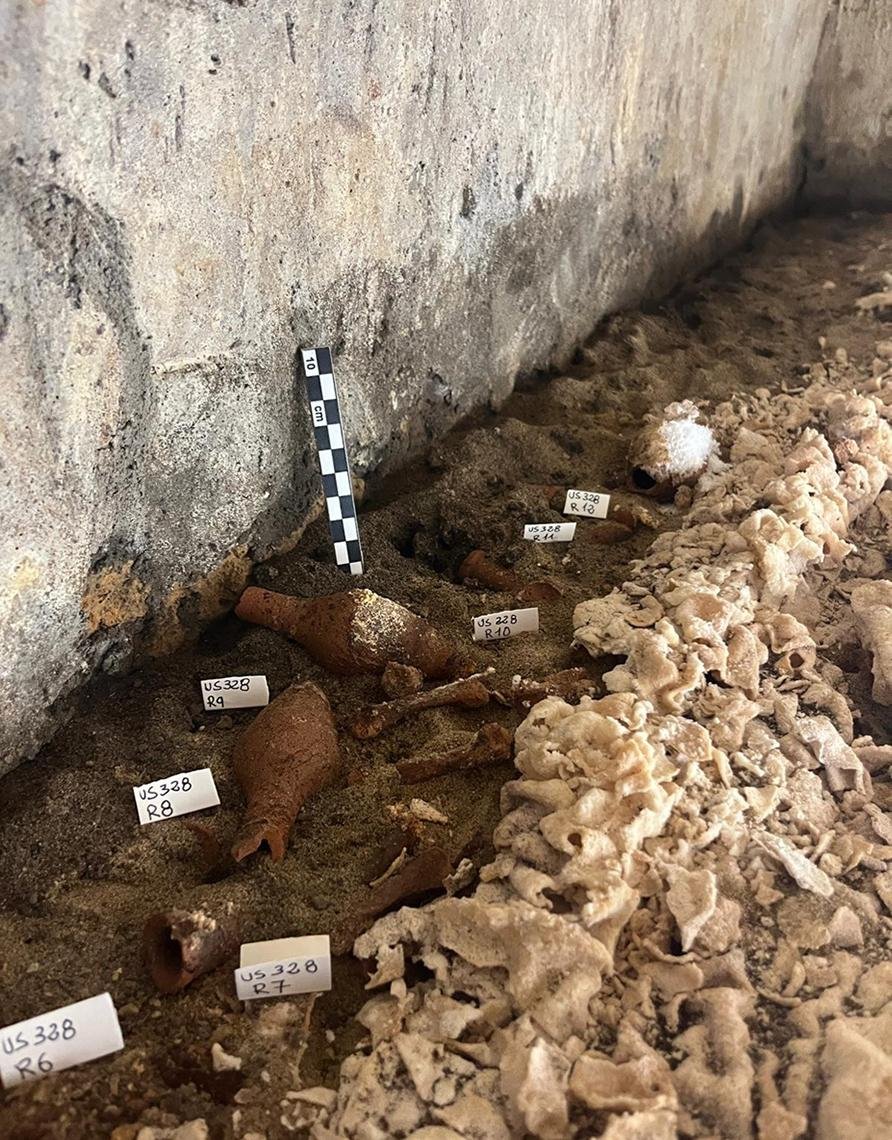For the first time in over 2,000 years, the contents of the sealed sarcophagus inside the Tomb of Cerberus have been revealed. This vividly frescoed chamber tomb was discovered last year in Giugliano, near Naples. Using a microcamera, researchers managed to peer into the sarcophagus, revealing a supine body covered by a shroud, surrounded by grave goods, including pottery vessels, unguentaria, and strigils.
 Interior of sarcophagus with pottery vessels and mineralized shroud. Credit: Soprintendenza archeologia belle arti e paesaggio per l’area metropolitana di Napoli
Interior of sarcophagus with pottery vessels and mineralized shroud. Credit: Soprintendenza archeologia belle arti e paesaggio per l’area metropolitana di Napoli
The exceptional preservation of the burial is attributed to the unique conditions of the sealed chamber. The textile shroud was mineralized, offering a rare opportunity for detailed analysis. The careful construction of the tomb, along with the presence of significant grave goods, suggests that the deceased was a prominent figure, possibly the head of the family for whom the tomb was constructed.
Dr. Simona Formola, the lead archaeologist coordinating the excavation, said: “The Tomb of Cerberus continues to provide valuable information about the Phlegraean area near Liternum, expanding our knowledge of the past and offering opportunities for multidisciplinary research.” The site has garnered significant interest and funding, including support from the Ministry of Culture, which has enabled the resumption of excavations and restoration activities in the surrounding necropolis.
Superintendent Mariano Nuzzo said: “Laboratory analyses conducted on samples from the burials and depositional beds have yielded significant data on the treatment of bodies and the funerary rituals performed, greatly enriching our understanding.” This collaborative effort involves a diverse team of archaeologists, technicians, anthropologists, paleobotanists, and chemists, all working towards a common goal of interpreting the collected data.
Among the intriguing findings, pollen analysis and microscopic observations revealed the presence of chenopodium (goosefoot) and wormwood. These plants were likely used in creams applied to the bodies to aid in preservation. This analysis was conducted by archaeobotanist Monica Stanzione, in collaboration with Dr. Marco Marchesini and Dr. Silvia Marvelli from the Centro Agricoltura Ambiente “Giorgio Nicoli” (CAA). Further, textile analysis by Professor Margarita Gleba from the University of Padua’s laboratory has provided insights into the structure, type, and quality of the fabrics used.
DNA analysis of the human remains is ongoing, conducted by bioanthropologist Barbara Albanese in collaboration with Dr. Pontus Skoglund, Dr. Thomas Booth, and Dr. Sarah Johnston from the Skoglund Ancient Genomics Laboratory at the Francis Crick Insтιтute. This research aims to uncover more about the genetic makeup and lineage of the individuals buried in the tomb.
The Tomb of Cerberus, named for its ᴀssociation with the mythological guardian of the underworld, continues to be a focal point for archaeological research. The ongoing excavations in the surrounding necropolis, combined with the restoration of frescoes funded by the Ministry of Culture, promise to reveal more about the historical and social context of this ancient community.
Soprintendenza archeologia belle arti e paesaggio per l’area metropolitana di Napoli





